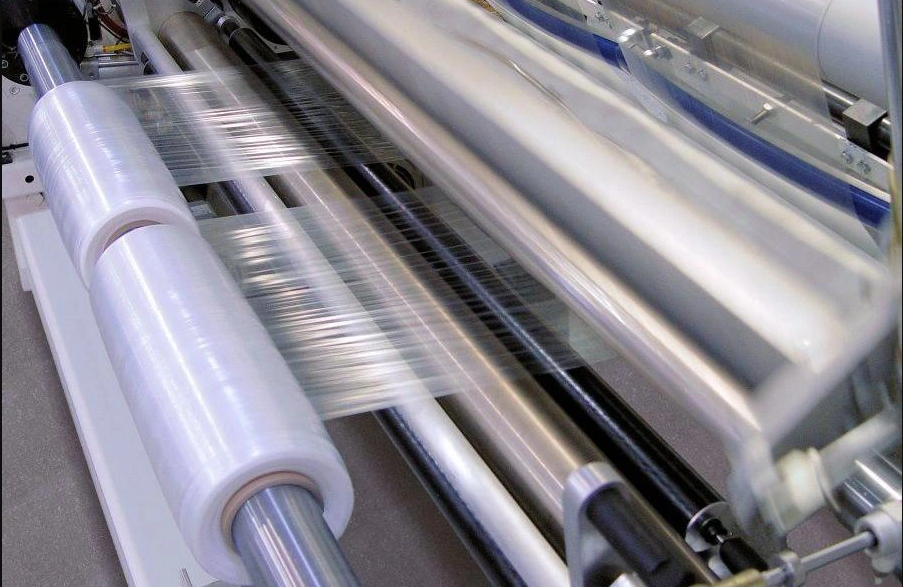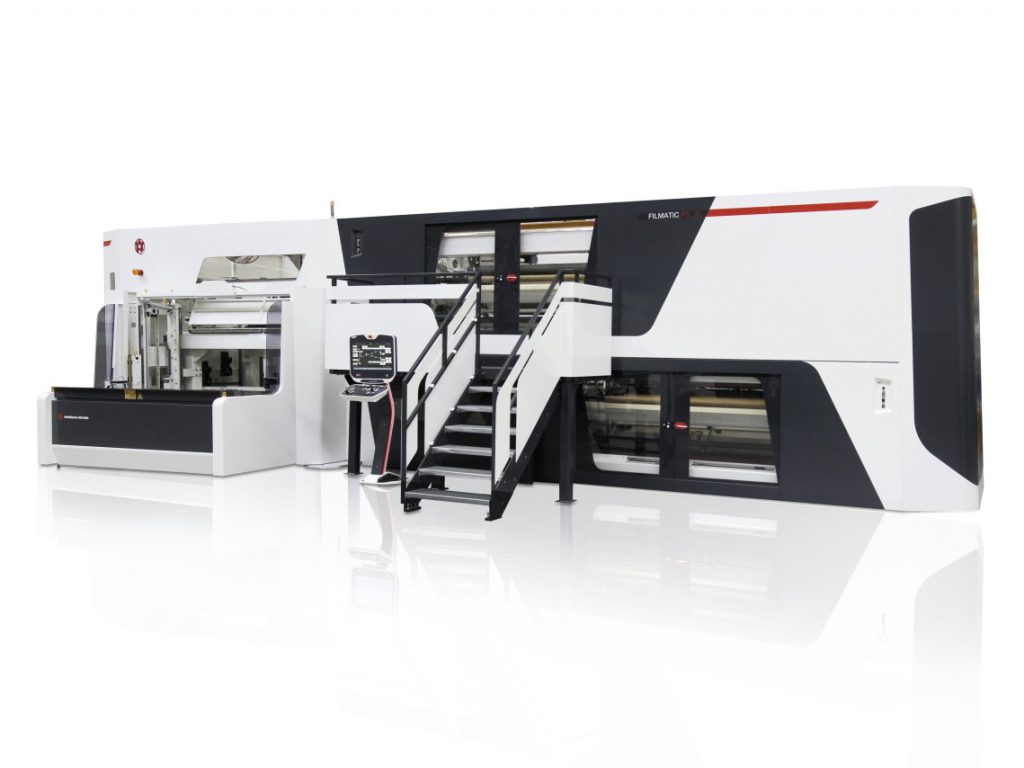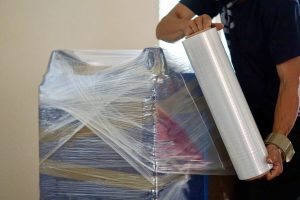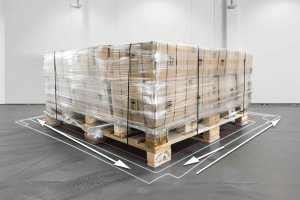
The Birth of Stretch Films: Revolutionising Load Stabilisation
As the global economy soared in the 1960s, products began crossing continents, especially in the FMCG industry.
A pressing need emerged: stabilising pallets to ensure the safe and efficient movement of goods.
However, suppliers faced three cumbersome options: loading hundreds of individual boxes onto a truck, using metal straps, or employing shrink bags to unitise loads.
Load unitisation became paramount.
All were time-consuming, labour-intensive, and costly.
In 1972, a breakthrough occurred when it was discovered that stretch film could secure loads effectively.
This innovation quickly gained popularity, and various types of stretch wraps became essential across industries such as manufacturing, e-commerce, agriculture, food and beverage, and more.
Stretch film offers numerous benefits:
- Cost-effective option for load unitisation.
- Minimises shipping damage.
- Keeps products free from dust and moisture.
- Enhances load handling, streamlining operations for loading and unloading pallets.
- Versatile and adaptable, usable on any surface, whether flat or pointed.
- UVI stretch films protect products from UV rays when stored outdoors.
- Opaque films conceal products, reducing theft and protecting valuable items.
The Evolution of Stretch Films

Stretch film has transformed the packaging industry with its cost-effective and efficient protection and securing of goods.
Over the years, it has evolved significantly to meet changing market demands.
The Early Days of Stretch Film
The Genesis
In the early days of packaging, the industry faced a significant challenge: how to efficiently and securely transport goods.
Traditional methods for stabilising loads, which were mentioned previously, were laborious, time-consuming, and not cost-effective.
These included:
- Loading individual boxes onto trucks: This method was highly inefficient and prone to errors and damage.
- Using metal straps: While metal straps provided some stability, they were difficult to apply, could damage the goods, and posed safety risks.
- Employing shrink bags: Though better than the previous two methods, shrink bags required heat to apply, which was another added complexity and cost.
The quest for a better solution led to the invention of stretch film in the early 1970s.
Manual Stretch Film
The first generation of stretch film was quite basic.
Made from simple plastic materials, these early films had to be manually applied to pallets and products.
Workers would stretch the film by hand, wrapping it around the items to secure them.
- Labour-Intensive: The manual application was highly labour-intensive and physically demanding. Workers had to exert significant effort to stretch and wrap the film tightly enough to secure the load.
- Time-Consuming: The process took a considerable amount of time, slowing down operations and increasing labour costs.
- Limited Protection: While early stretch films provided some degree of protection, they were still inferior for utmost load unitisation and good protection.
Early Benefits
Despite its drawbacks, early stretch film brought about several key benefits that made it a preferable alternative to the existing methods:
- Improved Load Stability: Even in its basic form, the stretch film significantly improved the stability of palletised goods, reducing the risk of products shifting during transit.
- Cost Savings: Over time, the stretch film proved to be more cost-effective than metal straps or shrink bags, as it reduced the amount of labour and materials needed.
- Versatility: Stretch film can be used on a variety of products and surfaces, making it a versatile solution for different industries.
Evolution and Innovation
The limitations of early stretch film prompted continuous innovation.
As the demand for more efficient and protective packaging solutions grew, the industry saw several key developments:
- Introduction of Machine Stretch Film: Machine stretch film was developed to address labour and time challenges. This type of film is used with automated stretch-wrapping machines, which, with the advancement of wrapping machines in the US then, drastically improves the speed and efficiency of the wrapping process.
- Material Improvements: Advances in plastic materials, particularly the development of LLDPE (Linear Low-Density Polyethylene), provided better elasticity and durability compared to the original LDPE (Low-Density Polyethylene). This can be attributed to technological advancements and chemical companies’ innovations in resin development.
- Enhanced Protection: Newer films have better properties, offering better protection and load unitisation, ensuring that products remain stabilised and protected.
The Impact
The advent of stretch film marked a significant turning point in the packaging industry. It not only streamlined operations but also enhanced the safety and security of goods during transit.
As a result, stretch film quickly became a standard in various industries, from manufacturing and e-commerce to agriculture and food and beverage.
Today, the legacy of early stretch film continues to influence modern packaging solutions.
The innovations born out of the challenges of the 1960s and 1970s have paved the way for advanced materials, automated systems, and environmentally friendly options that we see today.
Simplifying Stretch Film
Stretch film can be characterised based on three parameters. Innovations across these characteristics have made stretch films more efficient and environmentally friendly.
1. Material
Typically made from polyethene resin and additives, each material offers unique benefits, limitations, and use cases.
Traditionally, materials like LDPE and LLDPE have been used to create stretch films.
LDPE is durable, while LLDPE is more elastic and durable.
Today, most stretch films are made from LLDPE.
However, these materials are derived from non-renewable crude oil and are rarely recycled, contributing to environmental issues.
Thong Guan has long been committed to creating sustainable products and envisioning a cleaner future for the next generations.
Collaborating with Dow, TG has emerged as one of the few companies in APAC to produce stretch cling films made with renewable feedstock. Introducing NanoBio under the TG Bio Series, NanoBio performs as well as, if not better than, traditional stretch films.
As a manufacturer, TG is in an important position to advocate for sustainability, and it has been doing so for decades.
With their own recycling facility that started in 2011, TG managed to produce recycled content stretch films while retaining the consistent quality performance of their films.
Some of their recycled stretch films include Maxstretch Green, Maxstretch Stealth, NanoGreen, and FlexLite30.
2. Gauge Rating
This refers to the film’s thickness, which is crucial for determining its strength, durability, and cost. It is typically measured in micrometres (µm) or mils (1 mil = 0.001 inch).
The gauge rating (or thickness) is crucial for ensuring product safety, cost-effectiveness, and efficient packaging.
Typically, stretch films range from 10 µm to 40 µm, depending on the load characteristics.
Lower gauge ratings suffice for uniform and lighter loads, while higher gauge ratings are needed for heavier loads.
Higher gauge ratings mean higher costs due to increased material use.
TG recognised the need for a product range with a lower gauge rating that still maintains high durability and puncture resistance. Over the years, products launched by TG promoted downgauging while maintaining load integrity.
As one of the earliest in Asia Pacific to advocate for downgauging, TG released its first thin gauge hand film in the APAC market in 2008. TG’s Maxstretch Series checks all these boxes, offering double the strength of traditional stretch films, high puncture resistance, and using up to 50% less film.
Consequently, TG launched nanolayered films starting with Nano33, Nano55, and Nano67, which are known today as the Next Series (formerly Nano Series). TG has expanded its product range to pre-stretched, speciality, and other high-performance solutions.
Understanding that downgauging for the sake of downgauging will not work to achieve consistent quality performance, the Newton Research and Development Centre (Newton Centre) was born under TG Group.
That begins the journey of load optimisation through using the right films on the right wrapping machine, with the right packing and wrapping methods to use the most optimum materials to achieve the optimum load integrity.
3. Number of Layers
More layers mean a film with more attributes and characteristics.
With heavy loads being transported across oceans, the demand for high-performance stretch films grew.
Traditionally, higher gauge films were used, but they were costly.
This led to the development of multilayered stretch films, which offer better clarity, puncture, and tear resistance than typical films.
Multilayer films also provide flexibility for customisation based on specific characteristics.
Thong Guan mastered the production of multilayered stretch films using nanotechnology, creating films much thinner than traditional ones.
TG has been at the forefront of innovation within the stretch film industry, working closely with Newton Centre to continually formulate and produce consistent quality performance stretch films globally.
Engineering Excellence: Thong Guan’s Manufacturing Mastery in Nano Stretch Film Innovation

Manufacturing technology in the stretch film market has evolved to ensure consistency and quality.
One of the newest revolutionary technologies is nanotechnology stretch films.
These films are produced by layering multiple nano-scale layers of polymer molecules together, resulting in a much more durable and flexible material.
The advantages of nano stretch film include:
- Stronger and more flexible compared to multi-layered stretch film.
- Minimal film is required to secure a load, reducing plastic waste.
- Improved cling and stretch properties, making it easier to wrap packages securely.
In 2016, TG proudly emerged as the pioneer company in Asia-Pacific to use nanotechnology in its stretch films.
Over the past eight years, TG has refined its nano stretch film development from 33 layers to 67 layers, enhancing quality performance to meet market needs.
TG is also the first stretch film producer in Malaysia to be audited and certified with Nano Trusted, a mark indicating the authenticity of their nano-stretch film at the true nanoscale level.

The Evolution of Thong Guan: Pioneering Customer-Centric Innovations
At Thong Guan (TG), the commitment to putting customer needs first is more than a principle; it’s a driving force behind every innovation.
We employ dedicated machinery for different products, ensuring no residual material from previous production runs and minimising changeovers.
This meticulous approach not only enhances manufacturing efficiency but also guarantees high-quality outputs that meet the diverse needs of consumers.
Recognising that one size doesn’t fit all, we developed a broad range of stretch films tailored to various customer requirements—from basics to ultra-high performance and speciality films.
Our ENGAGE program, in partnership with Newton Centre, also exemplifies this approach by offering customised stretch film solutions.
We evaluate each customer’s operations and needs thoroughly before delivering products that perfectly meet specific demands.
From films used to wrapping machines, how they stack their pallets and wrapping methods, ENGAGE looks at the holistic approach to ensuring load stability.
In an era when data-driven decision-making is crucial, TG has introduced the iPAK5, one of the most affordable IoT-based tracking tools on the market.
This advanced device can be attached to over 80% of machine pallet wrappers in the market, providing detailed usage reports that help customers optimise their film usage and reduce waste.
This not only improves cost efficiency but also supports sustainability efforts.
To further ensure product authenticity and customer peace of mind, every TG stretch film roll is equipped with a QR code.
This feature allows customers to verify the product’s genuineness and obtain film data for wrapper settings, reinforcing TG’s commitment to quality and transparency.
The Journey of Innovation: From Early Stretch Films to Nanotechnology

The story of TG’s evolution is a testament to relentless innovation and a deep understanding of market needs.
Initially, the packaging industry relied on basic plastic wraps that were manually applied, labour-intensive, and offered minimal protection. Recognising the limitations, TG began exploring better solutions.
The introduction of machine stretch film marked a significant advancement.
Designed for use with automated wrapping machines, this innovation allowed for faster, more efficient, and more consistent wrapping processes, addressing the early limitations of manual films.
However, TG didn’t stop there.
The pursuit of excellence led to the development of pre-stretched and high-performance specialty machine films, each offering unique benefits like cost-effectiveness, ease of handling, and enhanced protection.
These innovations were driven by TG’s understanding of the diverse and evolving needs of its customers.
A major milestone in TG’s journey was the adoption of nanotechnology in stretch film production.
As one of the first companies in APAC to achieve this, TG pioneered the creation of films that are not only thinner but also significantly stronger.
These nanotechnology films offer superior performance, consistently protecting goods while using less material, thereby reducing environmental impact.
Engineering Excellence and Global Reach
Thong Guan’s commitment to engineering excellence is evident in its state-of-the-art manufacturing capabilities.
The use of nanotechnology allows TG to produce stretch films with multiple nano-scale layers of polymer molecules, resulting in a material that is exceptionally durable and flexible.
This advanced technology ensures that even with minimal film usage, loads are securely wrapped, reducing plastic waste and enhancing sustainability.
TG’s global perspective, gained from its presence in regions such as Southeast Asia, China, Europe, and America, allows it to stay ahead of market trends and customer demands.
This “glocal” approach ensures that TG can adapt and cater to both local and global requirements, maintaining its position as an industry leader.
Customer-First Philosophy: The Core of Thong Guan
At the heart of TG’s success is a steadfast dedication to its customers.
By prioritising their needs and continuously innovating, TG has built a reputation for delivering high-quality, reliable, and efficient packaging solutions.
Whether through the ENGAGE program, the iPAK5 tracking tool, or the pioneering use of nanotechnology, every initiative at TG is designed to enhance customer satisfaction and drive industry standards forward.
Contact us at info@thongguan.com to discover how Thong Guan can meet all your secure packaging needs with cutting-edge solutions tailored just for you.



